Article
Telehealth an Adjustment for Both Doctors and Patients
Author(s):
New federal regulations allows psychiatrists to use popular video conferencing tools like Zoom for telehealth appointments.

The coronavirus disease 2019 (COVID-19) has forced most non-urgent medical appointments to occur virtually.
While there is an obvious adjustment for the psychiatric patient, doctors also must change their routine to effectively continue care.
In a virtual presentation as part of the American Psychiatric Association (APA) Spring Highlights Meeting 2020, Avram Fishkind, MD, chief executive officer and consultant of Emergency Psychiatry and Psychiatric Emergency Services Design at Empathic Soul Health explained how psychiatrists can seamlessly transition to telehealth during the duration of the ongoing pandemic.
Fishkind suggested psychiatrists pick a private location within their dwelling that is quiet but has a good compute or phone with the recommended software installed. They should also make sure the video is in frame so the patient can see most their body and face and the microphone is working correctly.
Some of the concerns in the new age of telehealth is delays in evaluation and treatment due to a failure of equipment. Other issues include insufficient information, failure of security protocols, and a lack of access to information that might otherwise be available if the doctor and patients were face-to-face.
However, despite the concerns, the main selling point of telehealth is the convenience.
“They’re able to access behavioral health specialists that would under the circumstances not be available,” Fishkind said. “They're going to be able to see a psychiatrist rapidly and there is work been done that shows that for example, people with certain personality disorders have more of a difficulty with boundaries, even transfer problems might to better and feel safer on the other side of the camera.”
Another advantage under the current constraints is there is more oversight from the psychiatrist. After a face-to-face meeting, the doctor will often give the patients a set of recommendations to follow. However, the patient then goes home and it is very difficult to ensure the instructions are being followed.
But in telemedicine, a user suffering from panic attacks can log on, ask questions and get help.
One of the challenges that has prevented telehealth from being widely implemented is federal regulations made it extremely difficult.
“And for years, various regulations prevented telepsychiatry from literally exploding across the united states and our profession,” Fishkind said. “You had to always be licensed in the state that the patient was located. There are rules that apply here that cross federal state board regulations with regard to this and you'll notice 45 states changed in-state requirements.”
However, since the pandemic started some of the cumbersome rules that made treating patients via telemedicine have been relaxed.
For example, the US Department of Health and Human Services has opted to waive penalty fees to healthcare providers that serve patients through “good faith” in everyday technology during the duration of the crisis.
“This means video communications like Facetime, Skype, Zoom, Facebook Messenger, and Google Hangouts can be used,” he said. “You can use any free standing telemedicine platform, or any video built into your electric medical records.”





